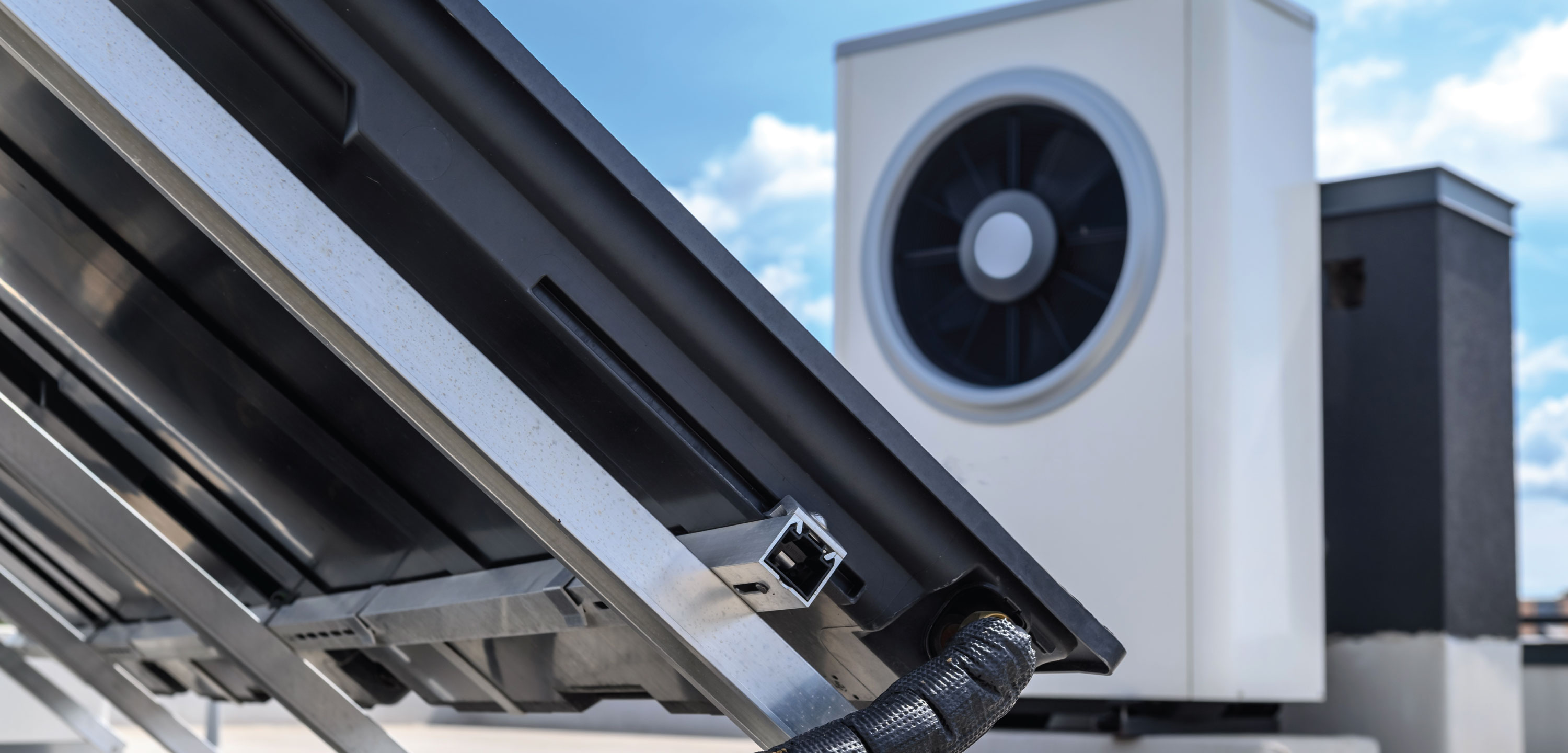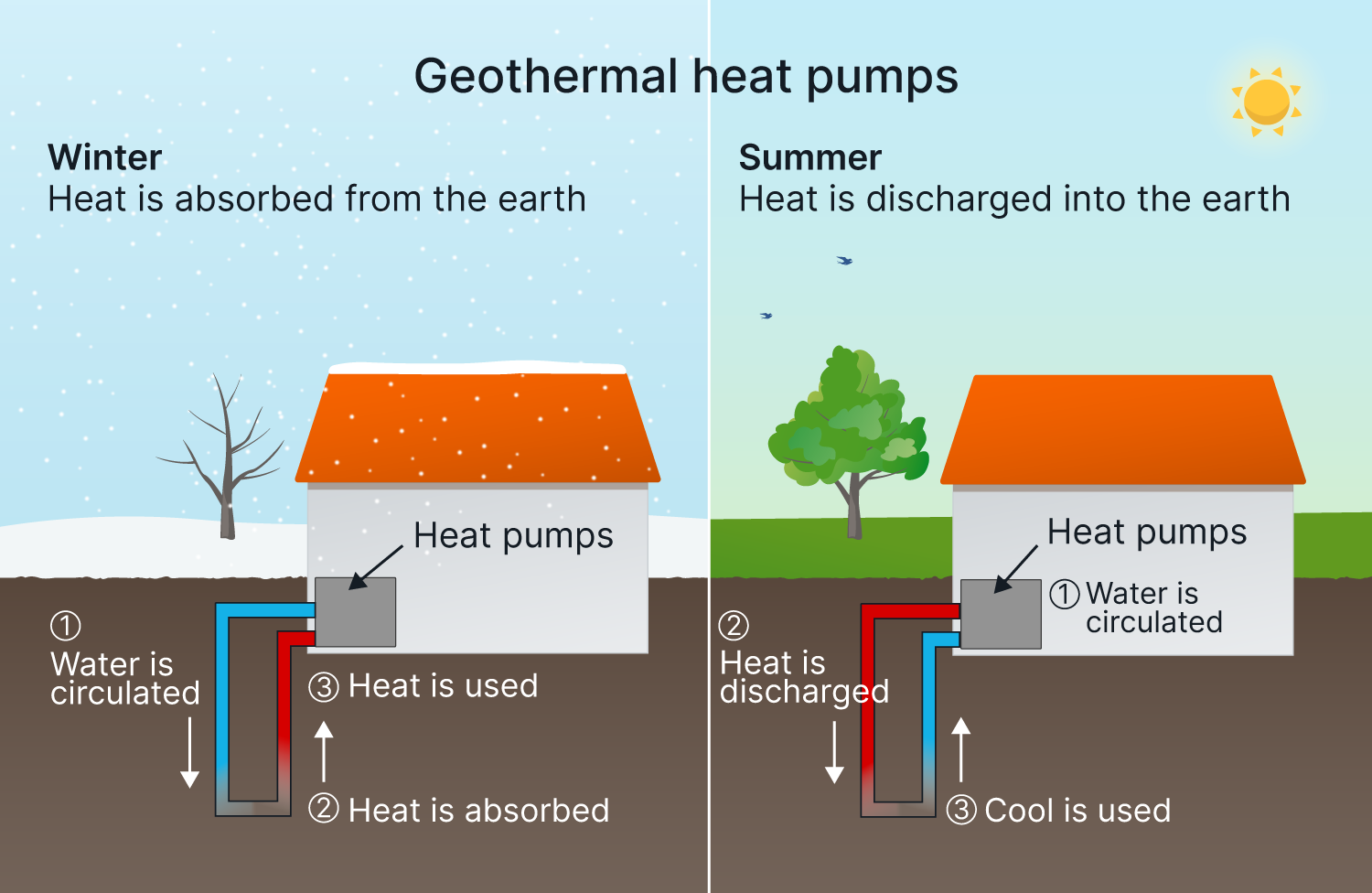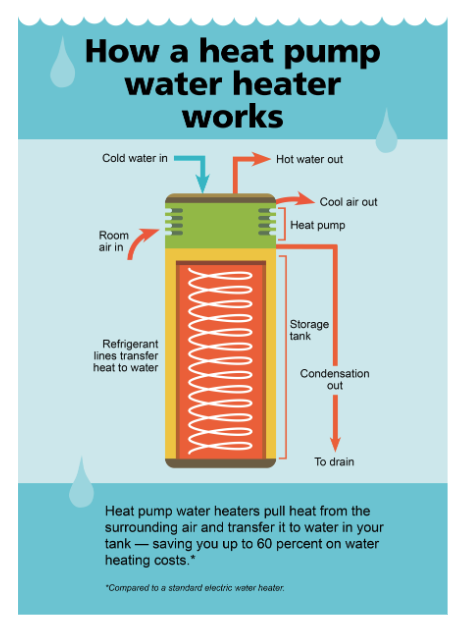Updated 8 months ago
How heat pumps reduce energy consumption and work with solar panels
Written by
Ben Zientara

Find out what solar panels cost in your area
Do you want to save money on your electricity bills, reduce your usage of fossil fuels, and improve life for everyone in your community? Heat pumps can do that.
By moving heat energy from one place to another, the various kinds of heat pumps can cool your home in the summer, heat it in the winter, and keep your water hot, using a fraction of the energy of traditional appliances.
What is a heat pump?
A heat pump is simply a device that uses electricity and refrigerant to transfer heat energy from a cool space to a warm space. If that sounds like a refrigerator or air conditioner, that’s because traditional fridges and air conditioners are heat pumps—they just operate in one direction.
Most of the heat pumps we’re discussing below work in both directions. They can keep your home cool in the summer and warm in the winter. Modern heat pumps are extremely efficient, meaning they cost less and use less electricity to operate than other ways of controlling your home’s interior temperature.
Heat pumps for home use
The most important kinds of heat pumps available today for residential use include the following:
Air-source heat pumps
Ground-source (geothermal) heat pumps
Heat pump water heaters
The first two are an either/or choice for home heating and cooling, while the third is Let’s look at each of these types of heat pumps in a little more detail.
Air source heat pumps
Put simply, an air source heat pump (ASHP) is an appliance that can move heat either into a space or out of it,using just the heat energy present in the air (even very cold winter air).
In terms of setup, ASHPs are remarkably similar to regular air conditioners (ACs). Both appliances share almost all their parts, and they both work by transferring heat by applying compression to coils. The main difference is that while ACs can only transfer heat from inside to outside the home - thus cooling the house - ASHPs can also transfer heat from the air outside to the inside of the house, helping to warm it up.
In recent years, ASHPs have become very efficient, generating heat with as little as a quarter of the energy required by traditional heat converters. Furthermore, improvements in heat pump technology mean you can now get special cold climate air source heat pumps (CC-ASHPs); these can produce heat in air temperatures as low as -22°F (-30°C).
For a more technical explanation of how ASHPs work, check out the video below:
Types of air source heat pumps
Air source heat pumps are a flexible heating/cooling option since they can be installed in many different configurations. The two most common types of setup are ducted and ductless.
A ducted air source heat pump connects to the home’s central systems of ducts and vents to provide either cool or heating to the entire house.
Ducted systems tend to have better air circulation and can work without the need for air handlers that can eat up living space. Ducted ASHPs can be installed from scratch or as a retrofit to a home with an existing ducted furnace system.
In ductless or mini-split systems, an outdoor compressor/condenser unit is connected to one to eight indoor units. Non-ducted ASHPs are easy to install, typically requiring only a three-inch bore in the wall for the conduit.
Having separate indoor units allows you to control the temperatures of individual rooms or spaces. Having different ‘zones’ in this house gives you greater control of your environment and also allows you to turn off the heating and cooling for unused spaces, thus saving energy.
Advantages of air source heat pumps
Energy efficiency: Heat pumps are up to four times more efficient than electric resistance-based heating systems
Lower running costs: As a result of their energy efficiency, ASHPs are much cheaper to operate than electric resistance heaters, and in most cases also cheaper than furnace or boiler heaters
Less environmental impact: Because of their greater energy efficiency, heating your home with an air source heat pump results in lower energy consumption, and thus a smaller carbon footprint; this benefit is amplified if you have access to clean energy sources, such home solar panels or green power from your utility
Not much more expensive than air conditioners: If you are considering buying an AC cooling system anyway, you might as well pay roughly 10-15% extra to upgrade to an air source heat pump
Better air control: A single outdoor compressor/conditioner can be connected to as many as eight indoor air handlers; this allows the creation of zones; you can separately adjust the temperature for each of them
Easy installation: If you’re installing a ductless air source heat pump, you will only need a three-inch hole for the conduit; this makes for an easier and quicker installation that can typically be done within a few hours. Central ASHPs systems are also relatively easy to install if ductwork is already installed
Rebates may be available: Many local governments and utilities offer rebates as part of their efforts to encourage energy efficiency and reduce carbon emissions
Disadvantages of air source heat pumps
Efficiency drops in low temperatures: While cold climate heat pumps can extract heat from outdoor air even in sub-freezing temperatures, their efficiency starts to drop the colder it gets; that means the efficiency advantage of air source heat pumps falls, or disappears completely, on very cold days
Supplementary heating may be required in the coldest climates: If you live in a cold climate that experiences temperatures below 0F, you may require an additional heat source to supplement the air source heat pump
Lower efficiency than ground source heat pumps: Another type of heat pump system - ground source (geothermal) heat pumps - are actually more efficient at generating; that said, ground source systems are almost much more expensive upfront)
Ground source heat pumps
Like air-source heat pumps, ground-source heat pumps (GSHPs) use electricity and refrigerant to control your home’s internal temperature, but as the name implies, they do it using the earth at your feet. That’s why GSHPs are also sometimes called “geothermal” heat pumps.
Rather than using coils inside the body of the condenser, the refrigerant is run through loops of underground tubing. Because the temperature underground is much more consistent than the air temperature, GSHPs are even more efficient.
How ground-source heat pumps work

The ground has a relatively constant temperature of between 50 and 60°F at all times. Heat, as you may remember from physics class, always flows from higher temperature substances to lower temperature substances. GHP systems take advantage of this principle, using the ground as a heat sink in the summer, and as a heat source in the winter.
GHPs perform the heat transfer via fluid-filled tube loops to exchange heat with the soil. In the winter, the heat collected from underground is extracted by the heat pump, concentrated, and then transferred to the building via ductwork.
GHP systems are very efficient, with a temperature coefficient of between 3 and 5. This means that if you input 1 kilowatt (kWh) of electricity, the system will generate the equivalent of between 3 and 5 kWh of heat energy.
In the summer, the process works in the reverse. Heat from the house is now transferred to water, which passes underground, releasing its heat through the cooler ground.
Advantages of ground-source heat pumps
Works in all climates: Since the ground source heat pump draws on the steady year-round temperatures underground, it is capable of operating efficiently even during extremes of hot and cold. (Air source heat pumps, by contrast, become less efficient at cooling when temperatures are very high and less efficient at heating when temperatures fall very low).
Long life: Geothermal heat pumps are unique because of their extremely long lifespan. The underground infrastructure can be expected to comfortably last 50 years. The equipment above ground - the heat pump and exchanger - will need to be replaced sooner, probably after two decades or so.
Highly efficient: GSPHs have a coefficient performance of between 3 and 5. This is more efficient than any other type of heating or cooling system and EnergyStar says they are 45% more efficient than traditional HVACs.
Low operating costs: Due to the aforementioned operating efficiency, geothermal heat pump systems require very little electricity to run, and thus substantially reduce energy bills.
Quick payback period: Thanks to the utility bill savings, GSHPs have a payback period of 2-10 years, according to Energy.gov.
Environmentally friendly: Ground source heat pumps don’t burn any fuel during their operation. They require relatively little electricity - if you can source your power from clean sources, then a GSHP can operate with zero emissions.
Disadvantages of ground-source heat pumps (h4)
They can be costly to install, and even more costly to retrofit in an existing building
If something ever does go wrong with the refrigerant loop, repairs are very expensive
Heat pump water heaters
The final kind of heat pump in our roundup is the heat pump water heater (HPWH). Creating hot water is the second-largest component of home energy consumption, accounting for 12% of a typical home’s energy use. In the United States, over 85% of residences use natural gas or standard electric water heaters, though they are not very efficient.
HPWHs can be up to four times more efficient than electric water heaters, and with the rising cost of natural gas, can even save money compared to their methane-burning cousins.
How heat pump water heaters work

Just as with air- and ground-source heat pumps, HPWHs move heat from one place to another. Essentially, they operate as an air source heat pump that condenses heat energy from the air into a coil that runs inside the tank. The heat dissipates into the water and the coolant in the coil travels back to the pump to be charged with more heat.
Their performance relies on the level of heat in your air, so there are slight fluctuations in efficiency based on seasonality and where and how they are vented.
When you need more heat for your water than is available by moving heat from the air into your unit, the electric rods activate in the tank, functioning like a conventional electric water heater. That’s why heat pump water heaters are also called hybrid electric water heaters.
Effective setups draw warm air from your attic down into the unit, which then expels the cooler air back into your home or outside, based on the season. In this way, you can simultaneously heat your water and cool your air. Talk about a powerful setup.
Advantages of heat pump water heaters
Outstanding efficiency: Heat pump water heaters are three times more efficient than electric, and four times more efficient than gas.
Really cheap to run: HPWHs use a quarter to a third of the electricity needed to run a traditional electric water heater, saving the average family hundreds of dollars per year on their electricity bills
Act as an energy storage option: modern HPWHs are controlled by smartphone apps, which can set them to pre-heat water during midday when energy prices are low, and prevents them from turning on during the evening peak when prices are high. This essentially means your heat pump water heater can act like a battery!
Disadvantages of heat pump water heaters
High initial cost: HPWHs cost two to three times as much as traditional options, but can pay back that difference cost in just a few years, and also qualify for incentives
Require updates: HPWHs need adequate ventilation to pull heat energy from the air, and also require a condensate drain, either at floor level or via a pump to a traditional utility sink
Require ventilation and relative warmth: The area where an HPWH is installed must allow for some airflow and an ambient temperature above 39° F for the heat pump to work efficiently, although HPWHs almost always contain traditional electric heating elements as backup for cold days.
Heat pump incentive programs
Ground-source heat pumps qualify for the federal clean energy tax credit. Taxpayers can receive up to 30% of the cost to install heat pumps back as a tax credit. Read more at EnergyStar.gov.
Also, the Inflation Reduction Act set aside lots of money for states to fund incentive programs for switching from traditional home appliances to more efficient ones like air-source heat pumps and heat pump water heaters. These incentive programs are available on a state-by-state basis. Check your state government’s website for information on incentives for energy efficient appliances.
Utility companies also typically offer rebates and incentives for installing heat pumps. Look on your utility company’s website for information about these incentives, and also look into on-bill repayment options for energy efficiency improvements.
How heat pumps, solar, and batteries work together
Now for our favorite thing about everything we discussed above. Heat pumps help to make solar panels and batteries more effective in your home!
Because modern appliances like these are connected to the internet, they can be integrated into your home’s energy management system! With smart load controls from something like a Span panel or FranklinWH battery, you can set your smart appliances to work whenever your solar panels are producing more than you can use.
This is especially important if you don’t have net metering. You can use more of your own solar energy and avoid sending it back to the utility company for pennies on the dollar.
Additionally, if you’re on a time of use energy rate plan, you can pre-cool your home and pre-heat your water in the summer to avoid high peak power charges in the evening.
Final thoughts
Heat pumps truly represent a massive improvement in how we use electricity in our homes. They’re more efficient, don’t directly use any fossil fuels, and can be electronically scheduled to take advantage of excess solar generation and time-based utility rates.
Incentive programs are keeping installation costs reasonable and the energy savings you’ll enjoy will likely result in a positive financial outlook in the coming years. If you’re interested in switching to a heat pump or heat pump water heater, the time is now.
Ben Zientara is a writer, researcher, and solar policy analyst who has written about the residential solar industry, the electric grid, and state utility policy since 2013. His early work included leading the team that produced the annual State Solar Power Rankings Report for the Solar Power Rocks website from 2015 to 2020. The rankings were utilized and referenced by a diverse mix of policymakers, advocacy groups, and media including The Center...
Learn more about Ben Zientara